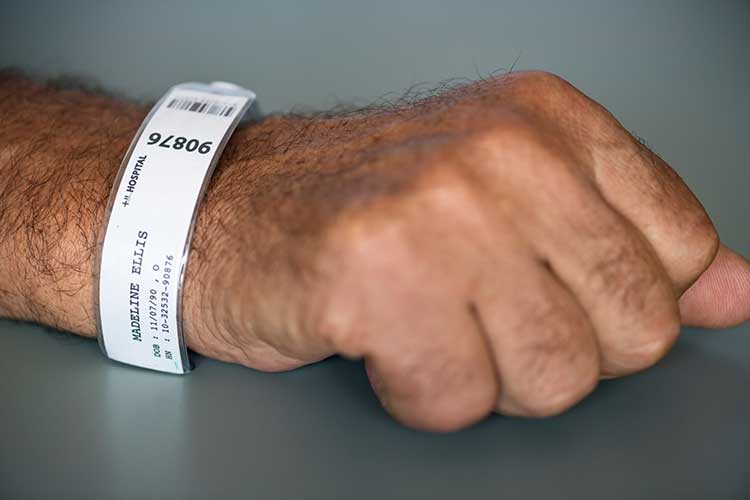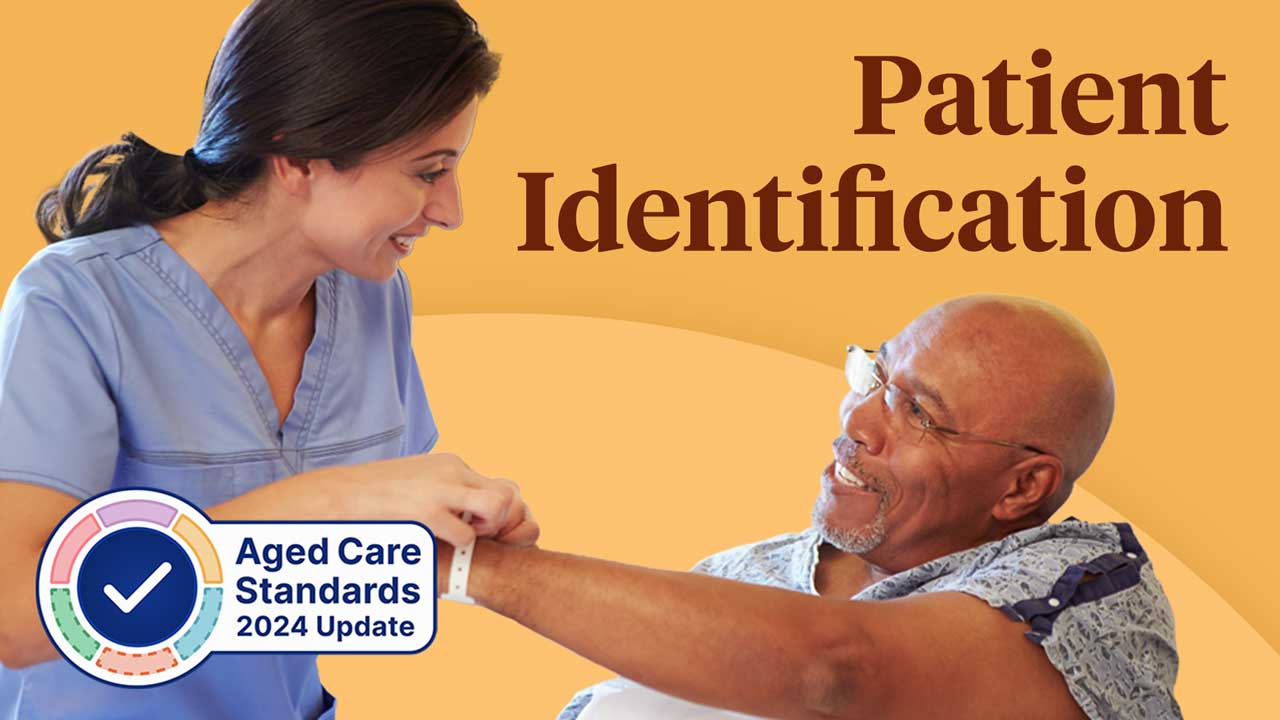Identifying the right patient is something we are taught from day one when training as medical professionals. This ensures that the right procedure is carried out on the right patient at the right time.
Mistakes can and will happen, which is why correct identification and procedure matching are crucial for minimising risk and keeping our patients safe.
It is important to consistently check the patient’s identity and match it with their intended care throughout their hospital stay. Also, ensure this has been correctly documented.
Correct Identification and Procedure Matching in the National Safety and Quality Health Service Standards
Correct identification and procedure matching are outlined in Actions 6.05 and 6.06 of the National Safety and Quality Health Service Standards, under Standard 6: Communicating for Safety.
Action 6.05
This action aims to ensure healthcare organisations maintain a comprehensive, organisation-wide system in order to ensure the reliable and correct identification of patients (ACSQHC 2018).
Organisations should:
- Define approved identifiers according to best-practice guidelines
- Use at least three approved identifiers upon:
- Registration and admission
- Providing care, medicines, therapy or other services
- Generating clinical handover, transfer or discharge documentation.
(ACSQHC 2018)
Action 6.06
This action aims to ensure healthcare organisations have explicit processes in place to correctly match patients with their intended care so that the right patient receives the right care (ACSQHC 2021).
Organisations should:
- Specify processes for correctly matching patients to their care
- Document the process of correctly matching patients to their intended care.
(ACSQHC 2021)
Correct Identification and Procedure Matching Under the Strengthened Aged Care Quality Standards
Standard 3: Care and Services - Outcome 3.3: Communicating for safety and quality under the strengthened Aged Care Quality Standards (Action 3.3.4) requires aged care providers to implement processes for correctly identifying and matching older people to their care and services (ACQSC 2024a).
Additionally, Standard 5: Clinical Care - Outcome 5.1: Clinical Governance (Action 5.1.5) requires providers to work towards establishing a digital clinical information system that uses national Healthcare Identifiers (ACQSC 2024b).
What are the Approved Identifiers?

There are six approved identifiers that can be used to ensure the right patient is matched with the right procedure. These include:
- Name (family and given names)
- Address
- Date of birth
- Gender
- Healthcare record number
- Individual Healthcare Identifier (IHI).
(ACSQHC 2018)
Three of these must be used every time a procedure is discussed with the patient or about to be carried out to safeguard against medical errors or breaches of confidentiality.
Why are Three Approved Patient Identifiers Required?
Studies in the USA have found that the risk of false matching decreases dramatically from a 2-in-3 chance to a 1-in-3500 chance when first and last name, postcode and date of birth are used to identify a patient, compared to last name alone (ACSQHC 2019).
Some names are common, so it is not unusual to have two patients in the same ward with the same last name (or both names). In this case, it is vital that other identifying information is used before carrying out a procedure (ACSQHC 2019).
Identity Checking at Admission and Registration
As soon as the patient enters the ward or surgical suite, it is crucial to check that they are the expected person for the planned procedure or care.
Clinical registration or hospital admission policies need to clearly document how to identify the patient using three of the approved identifiers.
This information should be obtained by:
- Checking the appointment letter against the patient list
- Asking the patient to confirm key identifiers - typically name, address and date of birth
- Ensuring that all documentation, medical notes and electronic systems used match the patient in front of you
- Ensuring that all paperwork is present and identifiers match if the patient has been transferred from another department.
Asking the Patient for Identifier Information
This is the best way to ensure that the correct patient is in front of you and is expecting the same procedure that you have listed.
Mistakes can happen when appointments are made, letters are dispatched or transfers are made between departments. Unless their cognitive function is impaired, the patient knows themself and what they’re expecting best.
However, it is important to bear in mind that some patients’ anxiety will prevent them from processing information correctly, meaning that they may nod and agree with something that’s incorrect. Using open-ended questions along with checking the identity band against your notes is the best way to ensure a positive match.
There will be some situations where the patient is unconscious and unable to provide the information required.
In these instances, every effort must be made to identify the correct patient, but identifiers may be limited to medical number and gender without the patient being able to confirm their name, address and date of birth.
Therefore, prior documentation of the patient’s identity and confirmation that clinical handover at every stage has been handled correctly are important.
What Information Must You Record and Document?
You must ensure that the approved identifiers have been recorded. How this information has been obtained should also be documented.
Your organisation should have clear policies and procedures in place outlining where and how to document this information.
Remember that if it hasn’t been written down, you can’t prove you’ve done it - so take care with your notes and make sure they’re accurate.
ID Band Specifications

The patient identity wristband is consistently used to check for approved identifiers throughout a patient’s hospital stay and at each stage of treatment.
Whether it uses barcode technology or printed details, it is paramount that all details are correct so that positive identification can be confirmed.
The Australian Commission for Safety and Quality in Health Care has developed specifications for a national patient identification band to ensure standardised best-practice across the country.
Based on the principle that the primary purpose of the identification band is to identify the patient, the Commission believes that black text on a single white band with the core patient identifiers is the safest and most reliable way to present this information (ACSQHC 2008).
The identity band should only contain the following information:
- Name
- Date of birth
- Healthcare record number/healthcare identifier.
(ACSQHC 2008)
Family and given names should be clearly differentiated to prevent misidentification. The family name should appear first in upper case letters followed by the given names in title case, e.g. ‘DOE Jane’.
It’s important to remember that the wristband isn’t always right.
Errors can occur when inputting information into the computer system and may not be immediately spotted, so always ensure that you check the wristband with something else, such as the medical notes and your patient, where possible.
What Happens at Clinical Handover?
Where a clinical handover is needed at the end of a shift or for patient transfer, it is critical that all staff who are involved check the identity of the patient using three of the approved identifiers, ideally with the patient involved.Clinical handover often happens in the staff room or another area of the ward that is large enough for all team members to gather, however, this can lead to confusion if several patients and procedures are being discussed at the same time.
Bedside handover using the identity band and patient confirmation is the best way of ensuring the patient’s safety.
What Happens When Misidentification Occurs?
The term ‘sentinel event’ refers to a serious incident that was ‘wholly preventable and has caused serious harm to, or the death of, a patient’ (ACSQHC 2020).
One of the 10 recognised types of sentinel events in Australia is ‘surgery or other invasive procedure performed on the wrong patient resulting in serious harm or death’ (ACSQHC 2020).
Although this event is rare, it does happen. According to the Australian Productivity Commission’s 2023 report on government health services, it most recently occurred between 2019 and 2020.
Patient safety incidents and near misses associated with incorrect patient identification are a recognised problem internationally and have been identified as a key patient safety goal by agencies around the world.
When we fail to identify a patient correctly and match them with their intended procedure, the results can be disastrous. Potential consequences that might occur due to patient misidentification include:
- The wrong procedure being performed, or a procedure being performed on the wrong person, wrong side or wrong site
- Medication errors
- Blood transfusion errors
- Incorrect diagnostic tests being performed.
(ACSQHC 2013)
It is important to mention that these mistakes often harm two or more patients - for example, two patients with similar names receiving a procedure meant for the other or the implant reserved for one patient being used on another.
The World Health Organisation introduced the Surgical Safety Checklist in 2008 to ensure identification and safety checks are carried out at pre-anaesthetic induction, before skin incision is made, and before the patient leaves the operating theatre.
The use of the checklist has found a reduction in patient mortality and inpatient complications compared to non-use.
Conclusion
Patient identification errors can occur anywhere within the healthcare process and at any healthcare facility, which is why preventing mistakes is crucial.
Knowing and following your organisation's policies and processes with every patient is the best way to keep them safe and ensure they receive the treatment intended for them.
Test Your Knowledge
Question 1 of 3
Which one of the following is NOT an approved identifier?
Topics
References
- Aged Care Quality and Safety Commission 2024a, Standard 3: Care and Services, Australian Government, viewed 16 May 2024, https://www.health.gov.au/resources/publications/strengthened-aged-care-quality-standards-august-2025?language=en
- Aged Care Quality and Safety Commission 2024b, Standard 5: Clinical Care, Australian Government, viewed 16 May 2024, https://www.health.gov.au/resources/publications/strengthened-aged-care-quality-standards-august-2025?language=en
- Australian Commission on Safety and Quality in Health Care 2018, Action 6.05, Australian Government, viewed 15 May 2024, https://www.safetyandquality.gov.au/standards/nsqhs-standards/communicating-safety-standard/correct-identification-and-procedure-matching/action-605
- Australian Commission on Safety and Quality in Health Care 2021, Action 6.06, Australian Government, viewed 15 May 2024, https://www.safetyandquality.gov.au/standards/nsqhs-standards/communicating-safety-standard/correct-identification-and-procedure-matching/action-606
- Australian Commission on Safety and Quality in Health Care 2020, Australian Sentinel Events List (Version 2), Australian Government, viewed 16 May 2024, https://www.safetyandquality.gov.au/publications-and-resources/resource-library/australian-sentinel-events-list-version-2-specifications
- Australian Commission on Safety and Quality in Health Care 2019, Correct Identification and Procedure Matching, Australian Government, viewed 16 May 2024, https://www.safetyandquality.gov.au/standards/nsqhs-standards/communicating-safety-standard/correct-identification-and-procedure-matching
- Australian Commission on Safety and Quality in Health Care 2013, Patient Identification, Australian Government, viewed 16 May 2024, https://www.safetyandquality.gov.au/our-work/communicating-safety/patient-identification
- Australian Commission on Safety and Quality in Health Care 2008, Specifications For a Standard Patient Identification Band, Australian Government, viewed 16 May 2024, https://www.safetyandquality.gov.au/our-work/communicating-safety/patient-identification/specification-standard-patient-identification-band
- Australian Commission on Safety and Quality in Health Care 2012, Standard 5 Patient Identification and Procedure Matching Safety and Quality Improvement Guide, 22 May 2018, https://www.safetyandquality.gov.au/wp-content/uploads/2012/10/Standard5_Oct_2012_WEB.pdf
- Australian Productivity Commission 2023, ‘12 Public Hospitals’, in Report on Government Services 2023, viewed 16 May 2024, https://www.pc.gov.au/ongoing/report-on-government-services/2023/health/public-hospitals
- World Health Organisation 2008, WHO Surgical Safety Checklist, WHO, viewed 16 May 2024, https://www.who.int/teams/integrated-health-services/patient-safety/research/safe-surgery/tool-and-resources
 New
New 
